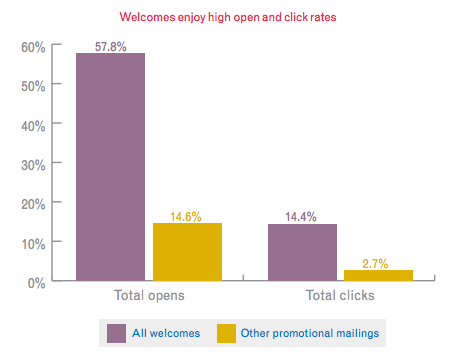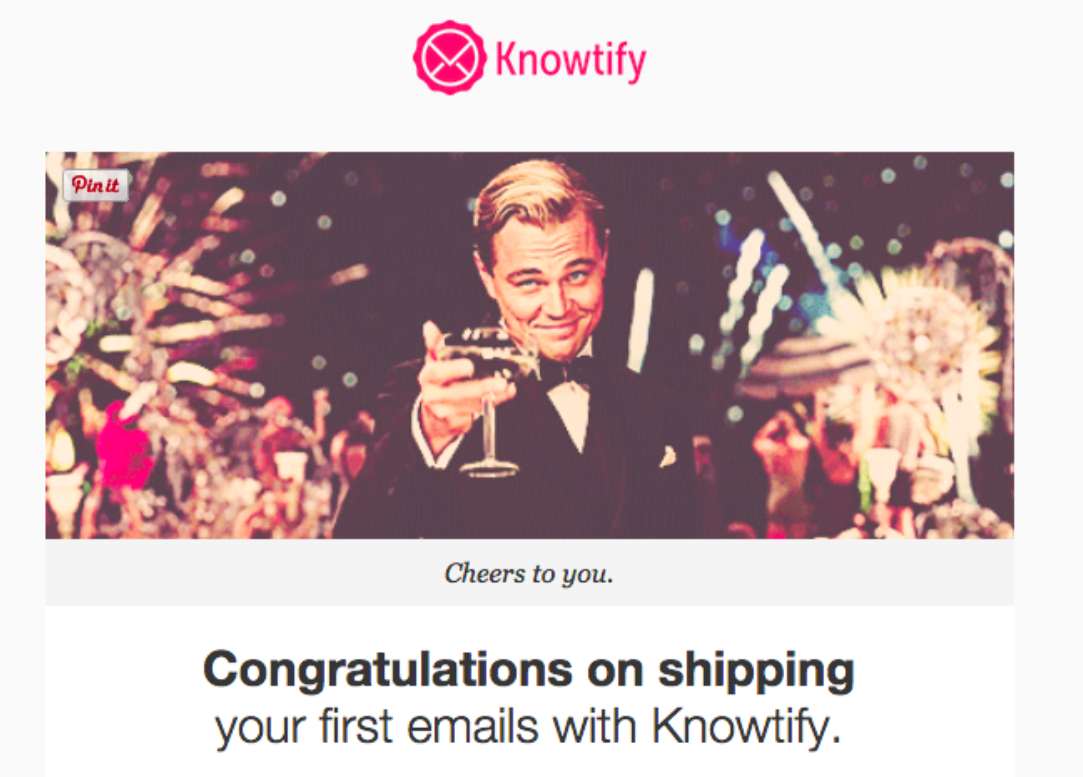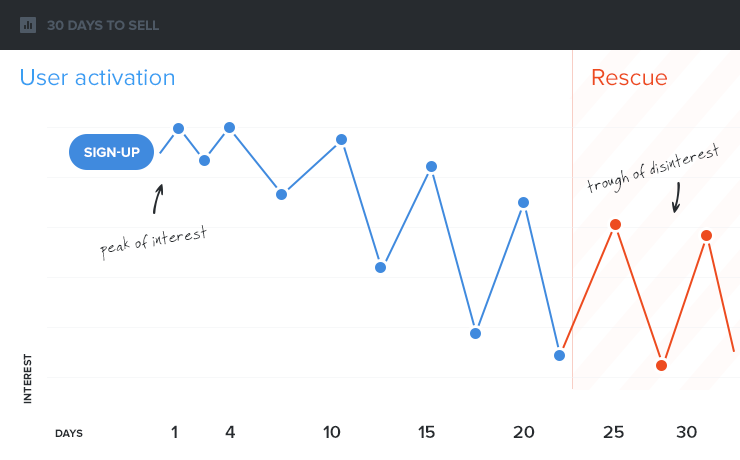Today I bring you a tale of high hopes.
The story goes like this:
One day a girl signed up for a free trial of a piece of software to see if she liked it better than the one she was using for the same task.
She loved the way the app worked (so simple!) and the first few days of using it were wonderful. She got emails full of useful information that weren’t overwhelming. She felt respected, cared for, and excited.
As time went by her 30-day free trial carried on but her use of the app waned.
After all, she was pretty used to using that other piece of software for this task so the new one didn’t have any stickiness for her.
The emails died down.
Things got real quiet.
And she disappeared from that new software.
Stopped using it altogether.
With no real incentive (or reminder) to keep going, she defaulted to her old ways and kept using that other piece of software even though it was slightly harder to use and cost more.
This, my friend, is a tale as old as time.
Perhaps it’s a familiar story for you. Maybe you’ve been that girl (or guy).
Here’s the thing. According to Ben Yoskovitz, founder of Instigator Blog, “most people think that the purpose of onboarding is to get people signed up to their product. Maybe they’re thinking about the first user experience too and how that (hopefully!) delights them and encourages them to keep going. But onboarding is so much more. It’s real value is in improving long-term engagement.”
Long term = beyond a simple hello.
Oh, and that girl in the story I just told you? That’s me. The app? Harvest.
Here’s how it all went down:

The Stats:
30 day free trial
4 emails sent in 15 of those 30 days
0 additional emails
0 personal emails from a team member
If you’ve been around these onboarding tear downs, you can see where I’m going with this.
And while you’re likely catching on that there are missing emails here (we’ll get into that in a second), this time I’m not going to write emails for Harvest like I did for Calendly.
Today we’re going to unpack what’s there already and then I want to share some science with you–we’re going to talk about why this whole onboarding thing matters and what Ben meant when he said “onboarding is so much more”.
Ready to get schooled? Let’s go!
Social Studies 101
Emails with personalized subject lines are 26% more likely to be opened. – Campaign Monitor
Harvest seems to have gotten the memo on personalized subject lines (FWIW, pretty much every app I’ve signed up for lately does some kind of first name personalization in their subject lines).

That’s a pretty clear subject line, right?
But check it out. Look at that preview text (the text that appears in the inbox next to the subject line).
It’s the same message again.
And there isn’t anything in the subject line OR preview text that tells me my account info is inside this email:

Something like “Save this email, Val!” would make sense here as a subject line. Or preview text.
Look, it’s likely that this email is going to be opened no matter what is says in the subject line or preview text. According to Experian, initial welcome emails have “four times the total open rates and five times the click rates” compared to other emails.

Source1
So maybe you’re thinking, “okay so why worry about it then, Val?”
Because.
Every step of your onboarding experience matters. Why not kick it off on a high note? Lincoln Murphy, customer success expert, says “Having a poor onboarding experience for your customers can pretty much kill your growth … if not your business.”
Yikes.
Let’s not kill your business before it even gets off the ground.
Now, while the subject line/preview text could be updated a bit, let’s review what Harvest has going right here:
- clear instructions on what to do next
- nice color contrasting button so it stands out (using your brand colors on buttons doesn’t always make the most sense)
- Using questions as the subheads inside the email
- pointing to the Getting Started Guide for easy access
Lots of good stuff here!
And then there’s more…
Study Hall
It’s not enough to just point your customers toward your Getting Started Guide and hope for the best.
Your job is to show them, teach them, be the change you wish to see in the world.
(Pretty sure Gandhi was talking about onboarding there, right?)
And Harvest gets it done:

Harvest recognizes that plenty of people sign up for a new app and then run off and do roughly 47 other things. They don’t always take the time to get into it right away.
Maybe your new trial users poke around a bit, figure out core functions, decide they made a good choice to test your software for a bit, and then they head out to a meeting.
Three days after signing up, Harvest gives me a nudge to learn more with this email above.
Remember how this is a tale of high hopes?
This email rocks!
“Let’s Get Started” makes me feel like I’m not alone.
And it’s the foundation of a little customer experience trick found in the practice of Positive Psychology.
Barbara Fredrickson, Ph.D., is a research psychologist at the University of Michigan who specializes in the study of positive emotions. Her work has major implications for customer experience and onboarding fits squarely into that category:
If people feel grateful for your services, then that is the first step toward creating loyalty and engagement. In fact, I’ve done a lot of reading about gratitude. Theorists talk about how one way of repaying gratitude is with loyalty. And if you can harness that and find ways to make people feel grateful for what you’ve done for them, they’re more likely to repay you with loyalty.
By binding your company with the trial customer through a simple word–”let’s”–you build gratitude from that new user toward your brand and your team.
The missing link here for Harvest?
A personal touch.
All of the onboarding emails from Harvest are sent from “Harvest”, not a team member.
This particular email, the one pointing toward a free training workshop, would benefit from having a person’s name attached to it. Is there a person on the team who is going to lead this training? If it’s a rotating team, is there a department head who can represent the team?
Think through adding a personal touch to your emails and that gratitude and loyalty Barbara mentioned will skyrocket.
A Visit to the Guidance Counselor
A week into my 30-day free trial of Harvest, I get this email:

It’s nice enough but missing a bit of… punch.
And personalization.
Harvest has an opportunity to send real data from the app to their new users here.
Like this:

Or this:

Or this (with one of my favorite GIFs):

Or, for those customers who are still a bit inactive, try adding in screenshots of the app in action so they can get that “hey, I can do this!” feeling. Like this:

You have plenty of options for making this next point of contact one that matters.
Remember, onboarding emails should never be an afterthought.
This is how you’re connecting with new users.
This is how they know they’ve made a good choice.
This is how they’re going to choose to turn over their hard-earned money to you month after month.
Don’t phone it in.
Sending behavior triggered emails adds a deeper level of personalization with your user… and a reminder that the trial is an important time to get the most out of their account!
Calculus 101
Look, I never took calculus (#theatrekid) but onboarding math isn’t as hard as you might think.
You have 30 days to win a customer over.

And this is where the story of Harvest starts to go south.
After that check in email above… there’s just one more email from Harvest:

With basically the same boring message:
“We wanted to check in”
Cool. Glad that’s what you wanted, Harvest.
What about what I want?
If you check out that chart above, 15 days into a trial we’re headed quickly for that “trough of disinterest”.
So it’s important to connect in a way that matters to your user.
What matters? Laura Lopuch, an email conversion engineer for SaaS companies, has this to say:
Your SaaS user only cares about one thing: how will this app improve their life?
Relevance to your user’s life and situation are powerful. Don’t make your user do the heavy lifting on understanding on how your app improves their life. When you show your user how your app benefits their life, your likelihood of getting a conversion skyrockets.
This is your responsibility in your persuasive onboarding emails.
If you aren’t being persuasive at this point in your trial, you’ve all but lost your customer.
Hey, maybe that’s why Harvest stops emailing at this point.
They figure they’ve already lost me anyways.
¯\_(ツ)_/¯
They could have gamified the free trial like this:

Or tried a personal touch like this email:
Look, everyone wants to focus on the beginning of the onboarding experience. It’s the fun times. The honeymoon phase. The relationship is new and exciting and we all love each other.
But the “end” of the onboarding sequence (I put “end” in quotations because onboarding never really ends) is crucial to the ongoing relationship.
As former Head of Growth at ProdPad Nandini Jammi said:
Email automation goes wrong when you expect it to pick up the slack for you. But with us? Our onboarding emails help us start the conversation, but we’re always there on the other end of the line.
Our onboarding emails are just the beginning – a taste of who we are as a brand and as a company – and a preview of what’s to come.
So let’s wrap this tear down up properly, shall we?
The Good
- a really strong start
- not too many emails that it gets annoying
- clear calls to action
- not overwhelming (only one thing to do in each email)
The Bad
- all of the emails come from “Harvest” and not a person
- there’s no behavior-based emails
- the emails feel like an afterthought, like something someone said “we should do that” and implemented with little care for the research or data behind onboarding
The Ugly
- the last email happens on Day 15
- no other emails remind me of the end of my trial or what’s next
- no last chance, reactivate, or win-back emails
- did I mention no more emails after Day 15???
Look, this story is all too common. And the point here is to try to tell a new one. A story about customers who feel valued, onboarding experiences based on data and research, emails that connect with the real humans on the other side of the screen.
Harvest is doing a lot of things right and also has plenty of room for improvement.
But don’t we all?
So now it’s time to implement what you’ve learned! As the great Friedrich Nietzsche puts it so succinctly:
“The doer alone learneth.”
Go. Doeth.
Your Turn
What are your biggest takeaways from Harvest’s onboarding emails?
How will you apply those lessons to your business?
Have a set of emails you want to see dissected here? Send me a note at heygirl(at)valgeisler(dot)com with the details of where I can sign up! If I write up the review, I’ll share a draft with you before anyone else sees it.
Want more on email marketing?
Get the Open Rates Newsletter:
See weekly dissections of real campaigns showing up in inboxes everywhere.
Just enter your email below to get emails about emails. Meta.

